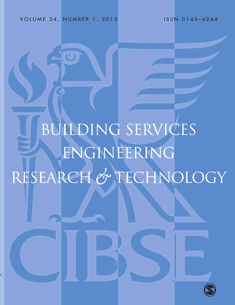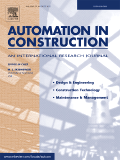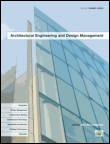
Bauphysik
Scope & Guideline
Fostering Knowledge in the Dynamics of Building Physics
Introduction
Aims and Scopes
- Building Physics and Energy Efficiency:
The journal extensively covers research on energy performance in buildings, focusing on methodologies for optimizing energy use, heat transfer, and thermal insulation in various construction types. - Sustainable Construction Practices:
Research addressing sustainable building materials, life cycle assessments, and environmentally friendly construction practices is a core area, reflecting a commitment to reducing the ecological footprint of the built environment. - Acoustic Performance and Indoor Climate:
The journal emphasizes studies on sound insulation, acoustic performance, and indoor environmental quality, aiming to improve living and working conditions through better design and materials. - Innovative Building Materials and Technologies:
There is a strong focus on the development and testing of new building materials and construction technologies, particularly those that enhance building performance, durability, and sustainability. - Regulatory and Standardization Frameworks:
The journal addresses the evolving regulatory landscape in building physics, providing insights into standards and guidelines that govern building practices and performance assessments.
Trending and Emerging
- Climate-Responsive Design:
Recent publications increasingly address climate adaptation strategies in building design, focusing on how to mitigate the impacts of climate change through innovative architectural solutions. - Digital Tools and Building Information Modeling (BIM):
There is a significant uptick in research related to digital tools, including BIM and simulation technologies, which facilitate better planning, design, and operational efficiency in building projects. - Circular Economy and Resource Efficiency:
Emerging themes emphasize circular construction practices, promoting resource efficiency and waste reduction in building projects, which align with broader sustainability goals. - Integration of Renewable Energy Systems:
The journal highlights the integration of renewable energy technologies, such as solar and geothermal systems, into building design, reflecting a shift towards energy self-sufficiency. - Health and Wellbeing in Built Environments:
There is a growing focus on the impact of built environments on occupant health and wellbeing, with research exploring indoor air quality, thermal comfort, and biophilic design principles.
Declining or Waning
- Traditional Construction Methods:
Research related to conventional construction practices has diminished, as the field moves towards more sustainable and innovative solutions that address contemporary challenges such as climate change. - Historical Building Techniques:
There is less emphasis on historical building techniques and materials, likely due to a growing focus on modern sustainable practices and technologies that provide better efficiency and environmental benefits. - Single-Focused Studies on Specific Materials:
The journal has shifted away from isolated studies on specific traditional materials, favoring more comprehensive approaches that integrate multiple factors affecting building performance. - Generalized Acoustic Studies:
While acoustic performance remains important, the focus has shifted from broad studies on sound insulation to more specific investigations that address particular challenges in modern building design. - Basic Theoretical Models without Practical Application:
The journal has decreased the publication of purely theoretical models that do not demonstrate practical applicability in real-world scenarios, directing attention instead to applied research that offers tangible solutions.
Similar Journals

Revista Ingenieria de Construccion
Shaping Tomorrow's Infrastructure Through Rigorous ResearchRevista Ingenieria de Construccion is a prominent open-access journal dedicated to advancing knowledge and practice in the fields of building and construction engineering, as well as civil and structural engineering. Published by the Pontificia Universidad Católica de Chile, specifically the Department of Engineering and Construction Management, this journal has been providing free access to quality research outputs since 1986, ensuring that vital information is available to both practitioners and academics globally. With its current placement in the Q4 category of both the Building and Construction and Civil and Structural Engineering quartiles, it serves as a platform for innovative studies and critical discussions, positioning itself strategically within the academic landscape. The journal is indexed in Scopus, ranking #157 in Building and Construction and #291 in Civil and Structural Engineering, reflecting the growing impact and relevance of its contributions. Researchers, professionals, and students are encouraged to engage with the rigorous and diverse content published within its pages, fostering a vibrant academic and practical discourse.

Journal of Green Building
Pioneering Research in Sustainable Design and Building PracticesJournal of Green Building, with its ISSNs 1552-6100 and 1943-4618, is a premier academic journal published by COLLEGE PUBLISHING in the United States. This journal, established in 2006 and continuing through 2024, serves as a vital platform for the dissemination of research on sustainable architecture, building technologies, and environmental design. With its current impact factor signifying a robust academic contribution, it is categorized in Q2 in Architecture and Q3 across several other disciplines, including Building and Construction, Environmental Engineering, and Public Health. The journal’s Scopus rankings demonstrate its strong positioning in the engineering and environmental science communities, making it an essential resource for researchers and professionals aiming to advance knowledge in green building practices. While it is not an Open Access journal, the rich content is pivotal for those involved in the critical intersection of sustainability and construction science. Whether you are a seasoned professional or a dedicated student, the Journal of Green Building offers invaluable insights that drive future innovations in eco-friendly building environments.

Smart and Sustainable Built Environment
Shaping resilient communities through innovative design.Smart and Sustainable Built Environment, published by Emerald Group Publishing Ltd, is a prestigious journal dedicated to advancing the knowledge and practice of sustainable development within the landscape of modern architecture, building, and civil engineering. With an impact factor that reflects its strong influence and standing—illustrated by its consistent categorization in the Q1 tier across several relevant fields including Architecture, Building and Construction, and Urban Studies—this journal has become an essential resource for researchers, practitioners, and policymakers alike. Operating in the vibrant academic backdrop of the United Kingdom, it aims to publish cutting-edge research that addresses critical issues at the intersection of sustainability and built environments. The journal is also indexed in Scopus with impressive rankings, ensuring visibility and credibility. The scope of the journal encompasses a broad array of topics, encouraging contributions that discuss innovative practices, policies, and technologies to foster smart and sustainable development. With its dedication to publishing high-quality research from 2012 to 2024, Smart and Sustainable Built Environment is at the forefront of fostering dialogue and collaboration in the pursuit of sustainable solutions for our built environment.

International Journal of Building Pathology and Adaptation
Exploring innovative pathways to building preservation.International Journal of Building Pathology and Adaptation is a premier publication dedicated to advancing knowledge in the field of building pathology and adaptation. Established by the esteemed Emerald Group Publishing Ltd, this journal serves as a vital platform for researchers and practitioners focusing on the assessment, preservation, and innovative adaptation of built environments. With an impressive Q2 ranking in both Building and Construction and Civil and Structural Engineering, and a Scopus ranking of #62 out of 223 in the relevant engineering disciplines, the journal showcases high-quality research with significant practical implications. Although currently not featuring an open-access model, its access options cater to a wide audience aiming to explore cutting-edge studies from 2017 to 2024. The journal's commitment to bridging the gap between academic inquiry and real-world application makes it an essential resource for anyone dedicated to advancing the resilience and sustainability of the built environment.

Building Services Engineering Research & Technology
Advancing Sustainable Solutions in Building Services EngineeringBuilding Services Engineering Research & Technology is a leading journal published by SAGE Publications Ltd, dedicated to advancing the field of building services engineering. With an ISSN of 0143-6244 and an E-ISSN of 1477-0849, the journal has established itself as a vital resource since its inception in 1980, operating as an essential platform for disseminating high-quality research and technological innovations up to 2024. The journal is well-respected within the academic community, reflected in its Q2 category ranking in Building and Construction and a commendable 67th percentile rank among the 223 journals in its field, according to Scopus. Although it does not offer open access, it provides extensive insights and rigorous studies that are invaluable for researchers, practitioners, and students alike. As a central hub for the exploration of cutting-edge methods and principles in building services, the journal aims to foster a better understanding of sustainable and innovative practices within the industry.

Developments in the Built Environment
Elevating knowledge and collaboration in built environment disciplines.Developments in the Built Environment, published by ELSEVIER, is a premier open-access journal dedicated to advancing knowledge across multiple facets of the built environment, including architecture, building and construction, civil and structural engineering, and computer-aided design. Since its inception in 2020, this journal has established an impressive Q1 ranking across various categories, reflecting its commitment to high-quality peer-reviewed research and its influential presence in the field, as evidenced by its strong Scopus rankings, such as Rank #7 in Engineering - Architecture. With an open-access model, it ensures that groundbreaking research is accessible to all, supporting the dissemination of innovative ideas and practices within the global community. Researchers, professionals, and students are encouraged to contribute to the discourse on sustainable design and technology, making this journal an essential resource for anyone engaged in the future of built environments.

Frontiers in Built Environment
Advancing sustainable solutions for urban futures.Frontiers in Built Environment, published by FRONTIERS MEDIA SA, is a highly regarded open-access journal that has established itself as a significant platform for cutting-edge research in the fields of building and construction, geography, planning and development, and urban studies. Since its inception in 2015, this journal has embraced a commitment to disseminating high-quality, peer-reviewed research, allowing researchers, professionals, and students to access pivotal findings and insights without financial barriers. With an impressive 2023 impact factor, it ranks in the Q1 tier for Urban Studies and is positioned within the Q2 tier for both Building and Construction and Geography, Planning and Development, demonstrating its influence and relevance in evolving urban and environmental challenges. Its rigorous indexing, exemplified by a strong Scopus ranking, reflects its contribution to the advancement of knowledge in these critical areas. With a clear dedication to fostering innovation and collaboration within the built environment sector, Frontiers in Built Environment is essential reading for those engaged in shaping sustainable urban futures.

AUTOMATION IN CONSTRUCTION
Elevating Engineering Standards with Automation InsightsAUTOMATION IN CONSTRUCTION is a premier academic journal published by Elsevier, dedicated to advancing the fields of Building and Construction, Civil and Structural Engineering, and Control and Systems Engineering. Since its inception in 1992, this journal has served as a vital platform for disseminating innovative research and practical applications in automation technologies within the construction industry. With a distinguished 2023 impact factor reflected in its Q1 ranking across multiple engineering categories—securing rank #3 in Civil and Structural Engineering and rank #3 in Building and Construction—AUTOMATION IN CONSTRUCTION stands out as a leading resource for researchers, professionals, and students keen on staying at the forefront of this rapidly evolving field. The journal offers access to cutting-edge studies that explore automation processes, methodologies, and tools, contributing to the enhancement of productivity and sustainability in construction practices. With contributions from global experts, each issue of AUTOMATION IN CONSTRUCTION provides comprehensive insights that help drive innovation and foster collaboration.

Architectural Engineering and Design Management
Advancing sustainable design and innovation in architecture.Architectural Engineering and Design Management, published by Taylor & Francis Ltd, is a leading journal dedicated to the interdisciplinary fields of architectural engineering and design management. Since its inception in 2005, the journal has established itself as an essential resource for researchers and practitioners, showcasing the latest developments and innovative practices within the architecture and construction industries. With a commendable impact factor reflected in its Q1 ranking in Architecture and high standings across building and construction, it addresses critical themes such as sustainable design, integrated construction processes, and management strategies that drive efficiency and creativity in evolving architectural contexts. Researchers will find the journal's commitment to disseminating high-quality research—evidenced by its impressive Scopus rankings, including a #13 ranking in Architecture—particularly valuable as it fosters a deeper understanding and advancement in the profession. The journal is accessible in print and online, ensuring that academic and professional communities stay at the forefront of architectural engineering innovation.

Intelligent Buildings International
Transforming Construction Through Cutting-Edge ResearchIntelligent Buildings International, published by Taylor & Francis Ltd, is a premier journal dedicated to advancing knowledge in the interdisciplinary domains of building construction, civil engineering, computer science applications, and planning. Since its inception in 2009, this journal has become a vital resource for researchers, professionals, and students, offering a platform for high-quality scholarly articles that explore innovative strategies and technologies in intelligent building design and efficiencies. With its significant impact factor reflected in its Q2 and Q3 quartile rankings across various related fields, and strong Scopus rankings placing it among the top journals in Geography, Building, and Civil Engineering, Intelligent Buildings International stands out for its commitment to fostering research that enhances the sustainability and functionality of contemporary architectural practices. Readers can access a wealth of articles that illuminate the complexities of smart building technologies and their implications for future construction practices, making it an essential addition to any academic library.